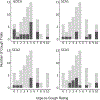Sensorimotor Cough Dysfunction in Cerebellar Ataxias
- PMID: 38032397
- PMCID: PMC11145628
- DOI: 10.1007/s12311-023-01635-0
Sensorimotor Cough Dysfunction in Cerebellar Ataxias
Abstract
Cerebellar ataxias are neurological conditions with a high prevalence of aspiration pneumonia and dysphagia. Recent research shows that sensorimotor cough dysfunction is associated with airway invasion and dysphagia in other neurological conditions and may increase the risk of pneumonia. Therefore, this study aimed to characterize sensorimotor cough function and its relationship with ataxia severity. Thirty-seven participants with cerebellar ataxia completed voluntary and/or reflex cough testing. Ataxia severity was assessed using the Scale for the Assessment and Rating of Ataxia (SARA). Linear multilevel models revealed voluntary cough peak expiratory flow rate (PEFR) estimates of 2.61 L/s and cough expired volume (CEV) estimates of 0.52 L. Reflex PEFR (1.82 L/s) and CEV (0.34 L) estimates were lower than voluntary PEFR and CEV estimates. Variability was higher for reflex PEFR (15.74% coefficient of variation [CoV]) than voluntary PEFR (12.13% CoV). 46% of participants generated at least two, two-cough responses following presentations of reflex cough stimuli. There was a small inverse relationship between ataxia severity and voluntary PEFR (β = -0.05, 95% CI: -0.09 - -0.01 L) and ataxia severity and voluntary CEV (β = -0.01, 95% CI: -0.02 - -0.004 L/s). Relationships between reflex cough motor outcomes (PEFR β = 0.03, 95% CI: -0.007-0.07 L/s; CEV β = 0.007, 95% CI: -0.004-0.02 L) and ataxia severity were not statistically robust. Results indicate that voluntary and reflex cough sensorimotor dysfunction is present in cerebellar ataxias and that increased severity of ataxia symptoms may impact voluntary cough function.
Keywords: Cerebellar ataxias; Cough; Cough expired volume; Peak expiratory flow rate.
© 2023. The Author(s), under exclusive licence to Springer Science+Business Media, LLC, part of Springer Nature.
Conflict of interest statement
Figures




References
-
- Isono C, Hirano M, Sakamoto H, Ueno S, Kusunoki S, Nakamura Y. Differences in dysphagia between spinocerebellar ataxia type 3 and type 6. Dysphagia 2013;28(3):413–8. - PubMed
-
- Isono C, Hirano M, Sakamoto H, Ueno S, Kusunoki S, Nakamura Y. Progression of dysphagia in spinocerebellar ataxia type 6. Dysphagia 2017;32(3):420–6. - PubMed
-
- Jardim LB, Pereira ML, Silveira I, Ferro A, Sequeiros J, Giugliani R. Neurologic findings in machado-joseph Disease: relation with Disease duration, subtypes, and (cag)n. Arch Neurol 2001;58(6):899–904. - PubMed
MeSH terms
Grants and funding
LinkOut - more resources
Full Text Sources
Medical

